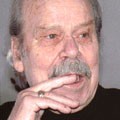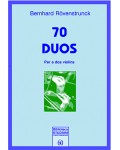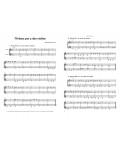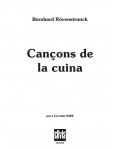
No products
Prices are tax included
Product successfully added to your shopping cart
There are 0 items in your cart. There is 1 item in your cart.
- English
- Castellano
- Català
Bernhard Rövenstrunck was born on 10 March, 1920 in Essen-Altendorf (Germany).
After working as a master bookbinder, he studied music at the Witte Conservatory in Essen and the Folkwang school of music and dance in the same city. He exercised as Chapel Master in Buchau am Federsee and in Wrngen Church in Ulm. He also worked as a teacher at an elementary school in Ulm and was a guitar and composition teacher at the State Music College in Trossingen.
His musical training comprised mastering a number of instruments, including the viola, oboe, organ and guitar, as well as conducting choirs and orchestras and mastering forms of composition. He was also gifted in the fields of literature, humanism, philosophy and theology. As well as his native language of German, he was fluent in Latin, French, English and Castilian, and also Catalan as well, having learnt it over the many times he visited Catalonia, after first accepting an invitation from his friend, composer Jaume Padrós, in 1948. He was extremely knowledgeable about ancient Catalan music and Catalan popular music with an ancient tradition, and assimilated them more than most of his contemporaries.
Although his compositions were not afforded the recognition they deserved in his own country, they were regularly performed and recorded in pre-Communist Prague.
His compositions ranged from works for many instruments and voices through to different sorts of chamber music, and from choral music to pieces for solo instruments, including unusual ones such as the guitar, accordion or the chalumeau, traditional instrument from Catalonia. He wrote many pieces aimed at people learning various instruments and all his theoretical works can be found in the Ulm Library under signature 69346, where they can be consulted. His later work is particularly important, such as the compositions on the poetry of San Juan de la Cruz, for its simplification of form and polished translation into German.
He died in October 2010 in Albstadt.
-
70 duos per a dos violins
Edition: DigitalThese duets were written with the aim of familiarizing violinists with playing techniques, introducing them to playing chamber music. They can also be played by other instruments such as cello, viola or piano.
12,46 € -
70 duos per a dos violins
Edition: PrintedThese duets were written with the aim of familiarizing violinists with playing techniques, introducing them to playing chamber music. They can also be played by other instruments such as cello, viola or piano.
21,42 € -
70 duos per a dos violins (n.1-10)
Edition: DigitalThese duets were written with the aim of familiarizing violinists with playing techniques, introducing them to playing chamber music. They can also be played by other instruments such as cello, viola or piano.
3,60 € -
70 duos per a dos violins (n.11-20)
Edition: DigitalThese duets were written with the aim of familiarizing violinists with playing techniques, introducing them to playing chamber music. They can also be played by other instruments such as cello, viola or piano.
3,60 € -
70 duos per a dos violins (n.21-30)
Edition: DigitalThese duets were written with the aim of familiarizing violinists with playing techniques, introducing them to playing chamber music. They can also be played by other instruments such as cello, viola or piano.
3,60 € -
70 duos per a dos violins (n.31-39)
Edition: DigitalThese duets were written with the aim of familiarizing violinists with playing techniques, introducing them to playing chamber music. They can also be played by other instruments such as cello, viola or piano.
3,60 € -
70 duos per a dos violins (n.40-48)
Edition: DigitalThese duets were written with the aim of familiarizing violinists with playing techniques, introducing them to playing chamber music. They can also be played by other instruments such as cello, viola or piano.
3,60 € -
70 duos per a dos violins (n.49-55)
Edition: DigitalThese duets were written with the aim of familiarizing violinists with playing techniques, introducing them to playing chamber music. They can also be played by other instruments such as cello, viola or piano.
3,60 € -
70 duos per a dos violins (n.56-64)
Edition: DigitalThese duets were written with the aim of familiarizing violinists with playing techniques, introducing them to playing chamber music. They can also be played by other instruments such as cello, viola or piano.
3,60 € -
70 duos per a dos violins (n.65-70)
Edition: DigitalThese duets were written with the aim of familiarizing violinists with playing techniques, introducing them to playing chamber music. They can also be played by other instruments such as cello, viola or piano.
3,60 € -
-














